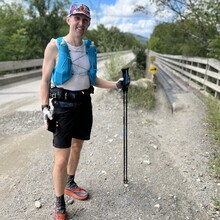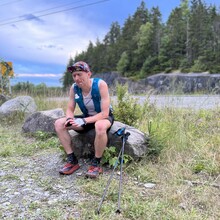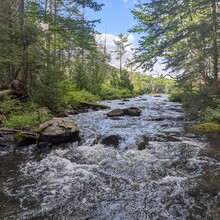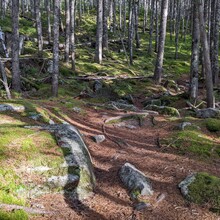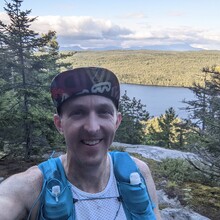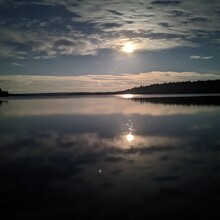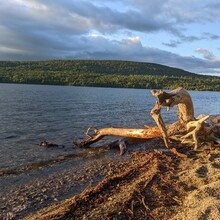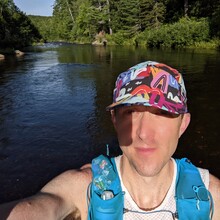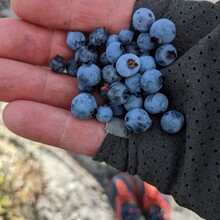Hundred Mile Wilderness Unsupported 2022
This was my big goal for the year. After running the Dartmouth 50 out and back last year, I realized that the Hundred Mile Wilderness times seemed within reach. At about 6 miles shorter and about 12000 ft less climbing, running 6 hours faster by not napping seemed eminently doable. Of course, I had never seen nor stepped foot on any of this portion of trail, but how hard could it be?
It was very hard. At the finish, I said: "That's the hardest I've ever worked to run a 19-minute mile." and "Every mile of that was the longest mile I've ever run." Indeed, for much of my run, the trail felt interminable.
Ultimately, I ran unsupported from the north side of Abol Bridge to the parking lot at ME-15 through the Hundred Mile Wilderness on the AT in 30:14:37. My track was broken by my watch dying (twice in short succession as I tried to charge the watch). I have a 15-minute interval track from the Somewear GPS beacon I brought with me as well. I brought all the food and gear needed from the beginning, filtered water myself along the route, and received no aid or support until the end.
Before I delve into details, some thanks are in order. Thank you to my family who have supported me in this madness, letting me get in long runs and even a few whole day adventures to prepare. They have also put up with incessant training talk, logistical talk, and my divided attention. Thanks also to friends: those who have guided me, trained with me, encouraged me, lent me gear, or all of the above! And special thanks to Alex for driving me in his Tesla spaceship all the way to the middle of nowhere, then picking me up on the other side of nowhere some 30 hours later!
A detailed account:
I set out to try to beat the supported time, but in unsupported fashion, much as Finn Melanson (s/o Singletrack podcast!) did in 2020. Finn's effort was changed to self-supported after he received some medical help from a thru-hiker, but he carried all his own food/supplies otherwise, so my effort here, as you'll read, comes with a big asterisk. His is really still the unsupported time to beat by all but a technicality.
I started at the northern (well, eastern) end of Abol Bridge, having been dropped off by Alex, who was having is own adventure as he pieces together runs forming a network connecting all towns in New England. On the car ride up that morning, I ate three bananas, some toast and peanut butter, and about a dozen Nutter Butter cookies (which was probably a horrible choice), then polished off a big helping of leftover pasta at Abol Bridge before putting on my shoes and pack and starting out. I took off at the stroke of 12:55 pm, Friday August 12, meaning I would need to finish before 6:01 pm to beat the supported FKT, and before 10:13:55 pm to beat the unsupported record (though Finn's effort is really the mark to beat).
I signed the hiker registry on the trail, and shortly thereafter saw large tracks in the mud on the trail, though I never saw the moose. Soon, I was passing lots of hikers. I would count over 120 on trail (not counting folks camping, splashing in lakes, or in the shelters) during my effort. It's pretty difficult to describe this as a "wilderness" or even as remote during thru-hiker season, and with all the forest road crossings, it never felt "out there" in the way my experience on high routes in the West has felt at times. That said, extraction would mostly be more difficult than just walking under my own power, so I never seriously entertained the notion of bailing.
The first miles were tougher than expected, and my heartrate limiter alarm on my watch (set foolishly high at 145 bpm) went off on virtually every uphill, however easy/slow I thought I was going. This should have been an early indicator to me of a few things:
1) this trail is tough, even though it doesn't have *that* much elevation gain by New England standards,
2) I was dehydrated, and
3) I needed to discard the nonsense splits pulled out of the air, and go by feel/HR instead of stubbornly trying to hit splits by burning matches in the first hours of a 30-hour effort!
All of these thoughts entered my head, but I was so doggedly focused on getting through the early "flat" 40 miles quickly so I could get to the hiking portion in the south where I thought the real difficulty lay. I wasn't entirely wrong about the relative difficulty, but burning matches wasn't the way to go; not with what was to come. I had been building to this effort since autumn of the previous year, when I realized it might be in reach, and now I was enthusiastically *going for it*, perhaps a little too recklessly, or haphazardly.
During my Dartmouth 50 out and back last year, I tried to smile at least once every mile. In spite of the pain I endured on this run, I managed that in the Hundred Mile Wilderness as well. I knew I was fit and well prepared, though probably better prepared for a 50k-50 mile mountain race than this kind of unsupported long hike/jog. Life circumstances had kept me from getting quite the right mix of training for this kind of slow effor, and life stress had been fairly high (by my standards). I slept less than 6 hours a night all nights the week leading into this effort, and I could feel the consequences almost immediately. My preoccupation on splits was focus of a sort, but it was seeing the trees, and missing the forest. Having a little more rest going in would've probably left me a little more mentally sharp to better debug and reconfigure. But I did keep smiling! What a treat to get to go out and do silly things like this! Thanks again to family and friends who got me here and allowed me do it.
Until it got dark around Jo-Mary Lake, I looked closely at my spreadsheet splits and where I was and how fast I was going. It was really based on not much of anything - certainly not knowledge of the footing I encountered, so I'm not sure why I held onto it so firmly. The footing was almost uniformly a wretched mix of jumbled glacial boulders (think microwave to stove sized) and densely woven, but uneven fir roots, which are uncomfortable and uneven and just plain slow to run on. Even the "flat" parts have little dips and rises that fail to make topo maps, but are steep enough to slow any running to a hike, only to try to start again. By mile 6, instead of a continuous smile, I smiled more intermittently, and thought about how surprisingly bad my legs felt for so early in the effort. I had hoped to hold out at least 50k without signs of wear and tear.
Gradually, I figured out that I hadn't been peeeing, and that I was probably dehydrated as I rushed to try to hit silly splits. I nursed my hydration back, but after an uncomfortable 900 Calories in the first 2 hours (roughly on target), I never came close again to my 475 Cal/hr target, at least 400 Cal/hr of which I really needed in order to not run out of glycogen fairly early in the effort. My stomach felt off. Things didn't taste good or sit comfortably in my stomach. I'm used to high-calorie fueling, so this was a bit of a surprise to me. After several hours and successful rehydration and a near constant stream of clear pee, I realized almost none of my snacks were high salt content, and my elecrolyte balance was probably off, causing absorption of nutrients in my intestines to function poorly and water to run right through. Rather than immediately stop and get the salt tabs out of my pack and put them somewhere I could reach while moving, I tried to eat my few saltier snacks and soldiered on, promising myself that when I stopped at dark, I'd shuffle things around and get the salt tabs. But then dark fell, and my lights were already conveniently placed so I didn't need a longer stop with my pack off. I delayed getting out the salt tabs longer, continuing to feel off. The only good things was that my legs didn't feel any worse than at mile 6.
Eventually, I hit smoother trails from along Nahmakanta Lake to partway up the north side of little Boardman. Some of this is a little slow, but it was all generally much faster and more runnable than anything I had hit earlier. I started clicking off miles on-pace, and my watch listed my net pace as essentially on target, but because my Caltopo map only listed the route at 92 miles, I still managed to be behind my intended arrival times at specific locations. Of course, at this point it was dark, and the AT is primarily marked and signed for folks heading north, so almost every trail intersection or junction by a shelter caused me pause, or even to trace the various paths out from the intersection looking for white blazes for a few minutes. It's of course helpful here that there's a common lichen that grows on fir trees in northern New England that's white and tends to grow in patches about the size and shape of the white blazes of the AT. I spent a little extra time off trail, which helped my intestines feel more normal and was on-message for my intended mantra of the effort, "keep moving", though it was off-key.
I hit my first *river* at Mud Brook, and after wading the crossing and getting my feet totally wet, I sat down to do my first filtering for a flask of Tailwind, and also got a salt tab, but failed to move the bag to an easily accessible location - this kind of small lapse of judgement became a theme that nibbled away at the margins throughout the effort, ensuring I didn't beat the supported time. It's difficult to focus for 30 hours, particularly on poor rest. The salt tab felt bad in my stomach at first, but then helped a bit. I managed to continue to eat a bit over 300 Cal/hr, but my snacks still didn't taste good. Everything was chocolate, which normally is great, but didn't feel great at the time.
As I jogged and hiked up the smooth trail to the base of Little Boardman, I couldn't help but think about how fast this could be in the other direction - even after most of the gain of the route in the legs, it seemed like such smooth, fast running - in the other direction. Nevertheless, I made steady progress, and though I was half an hour behind my intended splits, I knew that time was roughly 1.5 hours faster than Barry Howe's supported time on this segment in the opposite direction, and that I would just need to slow down less than expected on the steeper second half to make it up.
I knew there were a couple of river crossings that would necessitate getting my feet wet. But the sheer number I ultimately encountered surprised me: 7 of these, one of which was fully thigh deep, several of which had ropes strung up for crosser's safety. In the dark, each of these was kind of scary. As I later learned, some of these had been impassable due to high water only a few days earlier, and as it was, the water line was well above the normal banks of the river, so the trail just disappeared into the black current in the night. At each, I fiddled around trying to find a way to keep my feet dry, but usually that just ended in thrash and *then* wet feet, plus at least a couple of minutes playing what-shape-is-the-slippery-rock-below-the-surface, and how-deep-is-my-next-step to ccross the rivers.
It was good to switch to some more dedicated hiking up and jogging down Little Boardman, and I was happy my legs didn't feel much worse. Little niggles had come and caused moments of wondering if each new niggle would be my undoing, but each proceded to fade into the background as the effort went on. I hopped over some frogs on the trail and saw a few kangaroo mice hop out of my way, but that was it for wildlife during the night. There were loons calling to me in virtually every lake I passed during the light hours (which is awesome - I love the wild feeling of their calls), some chipmunks and squirrels and blackbirds, but not a lot of wildlife in all.
Another foot-soaking, unexpected river crossing later and I was headed up Whitecap, and felt both excited to now be past the 40 miles of "flat" and onto what I felt was the real test of the route, and also was a bit dazed and tired. The lack of sleep let my focus wander and I spent about 15 minutes at Logan Brook filtering water and probably bothering everyone there trying to sleep with my hundreds of lumens of waist and head lights bouncing around as I failed to find the trail out of the area (turned out, people were camped nearly on top of both the water source and trail out, so tough not to disturb them). The fatigue and under-fueling started to set in, but it was so lovely and cool, that I felt better anyway.
The predawn glow across the wilderness, lakes, and Katahdin massif was stunning. Truly, it was one of the most beautiful sights I've seen in New England to date. As soon as I took it in, I was moving and back in the trees, and soon it was light enough to switch off my waist light and headlamp. I took that moment to get my watch charge cable over and switch to charging it. As I was playing the USB-plug orientation game, the watch died. I narrowly missed keeping a single continuous GPS track. To make matters worse, when I finally got it charging and booted back up and tracking again, it bounced while running, and reset itself and hard-froze, requiring a manual restart. After that, I stopped trying to load the course, and just tracked instead. Perhaps that was the real undoing of my attempts to keep to specific splits, as I no longer had a great sense of exactly what lay ahead and how fast I should be going, and spent more time looking at my phone to figure out how much water I needed at each stop.
The heavy rains during the week leading into my effort, and then subsequent dry and cool conditions I enjoyed were a huge boon to my effort. Unfortunatley, I wasn't familiar enough with the route to take full advantage. The rains meant that virtually every seepage and trickle that could flow was flowing, and sources not even hinted on my maps were decent spots to fill. That meant I could have done the whole route with just my two front filter bottles, never filtering and filling my other bottles. That would've cut weight in my pack, cut fluid carrying weight, and cut a lot of time spent filtering (about 30 minutes total). But that knowledge could probably only have come from detailed route knowledge and/or detailed recent intel from someone trusted and who understood the specific needs for the dip-and-go filtering strategy at this pace (i.e. water every 3-5 miles is perfect, 6 is a bit long). Those rains however also led to the overflowing streams that might've been totally passable with dry feet the previous wekend, as the region is otherwise in dought. Of course, being a newbie to the area, I knew nothing of either concern, and didn't manage to mitigate the water crossing downside, or take advantage of the water availability upside.
The ridge over Hay, West, and Gulf Hagas felt slow, and I managed to go through the only grassy meadow of the whole route as it was covered in dew, soaking my feet again. The run down from Gulf Hagas Brook was much slower than I hoped, and I hadn't regained any time since the hills began. I also lost one of my non-filter bottles somewhere trying to run "fast" on this decent. That was a bit of a problem, given the long low-water-availability ridge coming up. I had marked a 9-mile section with no water sources on my map, and had planned to camel, then carry 2 liters to make it through; losing a bottle wasn't welcome news.
I spent another too-long time filtering and standing in the river, hoping that cooling my feet would help before heading up West Chairback. I power-hiked it - or at least, I felt like I put a lot into my legs and poles. Eating wasn't going so well, but I had some tailwind in my flasks that still wend down easily (again - salts! I needed them!). I managed to try to enjoy some of the brief meadowy area near the top, and picked some blueberries, but they tasted slightly sour to me. My mouth was pretty messed up and I had stopped producing much saliva at this point, and had to wash any food down with water just to get it out of my mouth, though I continued to pee frequenly and clear.
I worried a lot about water here. I filled a flask at a small trickle I found before the Chairback Pond outlet, then did another filter at Chairback Pond outlet. This wasn't helping me move forward, but I was trying to avoid total implosion due to dehydration.
After a brief view on Third Mountain, I don't recall any views until the tower on Barren Mountain and the trail seemed to hang below the ridge proper, senselessly wandering up and down the hill on virtually unrunnable trails. My mood was clearly shit, and I was bonking fully at this point. Nothing tasted good or felt good in my stomach. Only basic sugary things would go in: my homemade energy gel, the bit of Tailwind I had water for, fruit strips, and about one Oreo an hour. I think I was down to about 200 Cal/hr, or less than half what I needed to sustain reasonable output. At least I eventually found a water source that I wasn't expecting, but was very happy to see, given how long it was taking me to walk my way across the ridge. I passed a plane crash and took a photo. It looked about how I felt. I sent a satellite message to Alex that I was going to miss my estimated arrival time, and that he should order me a pizza in case I got there too late. He never saw that message.
I think I was equal parts relieved to finally see a view at Barren and relieved that meant the ridge was finally over, and I could go down. And what a steep downhill it was! I barely clocked hiking speeds going down, given how steep it was and how much my feet were starting to hurt. A hiker made a comment about runners on this section of trail, and I told him I started at Abol Bridge; I think he registered amazement, but my state of mind wasn't totally coherent. Crossing Long Pond Stream, my feet again got soaked, and this time, I knew it was trouble almost immediately. My feet started to hurt, but I got some crazy notion in my head about the possibility of closing hard and still making it under the overall record by running 4 mph to the end. After running harder than my limited calorie intake could sustain for about half a mile, I tossed in the towel on that idea, and started to wonder if I could beat the current unsupported time at all. Water was more plentiful now, and I managed to down a couple of salt tabs which kept me ingesting 200ish Cal/hr, even up to 300 Cal/hr for a couple of the final hours. But the terrain was unrelenting.
Another plunge of my feet in Wilson River and I was done. My feet were in total pain. I could tell they had fully pruned up inside my wet shoes, and now every footstrike pinched the skin all over my foot. It was excruciating. A few short sections of hardwoods had smoother, more even trail surfaces and I managed to muster a run again, but then I would be plunged back into the hellscape of fir tree roots and rocks that plagued me throughout. Since the start of the Chairback range though, it had all been horrific slate, tilted on its side so the jagged rough edge of the sedimentary layers faced up, making surfaces uneven and pointy - absolute agony for my feet, instead of runnable firm, predictable surfaces, as they would have been on dry feet.
I kept going. Every time I almost managed a running pace, I'd hit horrible roots, or another short 40% grade climb or descent that would slow me back to 2 mph. But eventually, I made it through. The lakes in the final 3-4 miles all had loons in them, and they all called loudly to me, though I couldn't see them. I also then ran into some people who asked me if I was Joffrey and told me to keep going, I was close! Then some guy asked if I was going for the FKT, and I said yes and kept going. Apparently, they had all run into Alex who had been out on a run, telling people I was headed their way (I had failed to convey this was poor form).
I ran the final hill up to the parking lot, and triggered my heart rate limit warning for the first time since darkness fell the previous day. I hit the parking lot and stopped my watch. Retrospectively looking at the timestamps in the GPX files, I see a start time of 12:55:01 on Aug. 12, and finish time of 19:19:38 on Aug. 13, for a 30:14:37 full time from the north side of Abol Bridge to the parking lot at Rt. 15.
I was so happy for the pain in my feet to stop. It was virtually the only thing I could hold in my head the final 15 miles, to the point that my legs actually felt fine, and I felt I could have run decently without the foot pain.
A story from the aftermath, because it's odd (or at least odd to me): Alex took me into town and we got some pizza. I ate 4 of my 6 slices, then decided my stomach had about as much as it could currently handle, and quit. Moments later, I felt as though I might faint. I told Alex as much, then sat back in my chair as the whole world faded visually, audibly, and otherwise perceptively. I may have actually lost consciousness briefly, and for a few minutes, I felt as though I had suddenly stood up too fast. Eventually, I reequilibrated and felt relatively normal, albeit tired and sore. This is the kind of thing that can happen for a variety of reasons, but I don't believe eating some pizza an hour after a very long run is usually one of them.
A week out now, and my feet have dried out and blisters draine, and can move around fully normally again. I think bonking and foot problems stopped me from really getting the most out of my body, and a hundred little decisions and happenstances fed into that. That has left me feeling rather unsatisfied by this attempt. I guess as an "onsight" attempt, to borrow the phrase from rock climbing, it was good. I came within spitting distance of some great athletes' times who have been through most or all of it multiple times. But knowing the surface now, and the relative lack of above-treeline time, compared even to something unremarkable and treed-in like the Dartmouth 50 out-and-back, I don't expect I'll be back for another go at the FKT. That said, this can and will go under 24 hours. Probably even by a non-elite (albeit very good) runner.
Summary of lessons:
* Knowing the route, terrain, and conditions helps in myriad ways, from setting hydration plans to setting split plans, to chosing shoes and foot management tactics.
* Over the course of (nearly) 100 miles, many things can go wrong, some can go right, and mitigating the former and taking advantage of the latter is key to getting the most out of yourself
* Being well-rested going into an overnight effort is vital to remaining sharp and focused over the course of 24+ hours
* River crossings can lead to big issues with feet
* Trouble-shooting issues with taking in calories early is important
* Take salty snacks on summer runs - even "cool" summer runs
* Having now gone SoBo, I'm pretty sure I agree with the majority that NoBo is the way to go, though either can probably still knock a bunch of time off the current records
* I thought my mental game was stronger than my physical game, but now I'm not so sure. I really failed to keep mental sharp and focused on the goal of moving forward, or on being able to really assess my situation nad determine the best tactics to enable longer term success
* It's difficult to train to be good at this kind of effort, and it's even more difficult to learn by doing because each takes so much time and energy
* Bringing a toothbrush is a great idea; my teeth hurt from all the sweets
Gear:
Hoka Speedgoat 4 wide
Salomon thin race socks
Salomon XA Shorts with stretchy waist pockets and hand pockets (so nice for stashing the snack you're currently working on)
Craft mesh undershirt/singlet
Naked Running Belt
Salomon Sense Pro 10 pack
Kogalla RA light with 20000 mAH battery (also used to charge watch)
Black Diamond Spot & 1 set of backup batteries
Somewear locator beacon
2x BeFree filters mounted to Hydrapak 500 ml soft flasks that fit the threading and fit in Salomon packs well
2x Salomon soft flasks for Tailwind drinks
Janji run hat
Extra pair of socks
Patagonia Houdini jacket (unused)
OR fingerless sun gloves
Black Diamond Carbon Distance Z poles (broke one near the end)
Trimmed down med kit including tape, Ace bandage, some blister repair items, some ibuprofen, space blanket
Squirrel's Nut Butter
Mask, credit card, ID, cash
Food:
~2400 Cal Tailwind unflavored
~3000 Cal homemade and other energy gels
~ 2000 Cal KitKat dark chocolate
~ 4650 Cal granola and other bars
~ 1300 Cal snack crackers
~ 1000 Cal fruit strips
~ 1200 Cal Dark Chocolate Oreos
~ 600 Cal commercial energy gel

